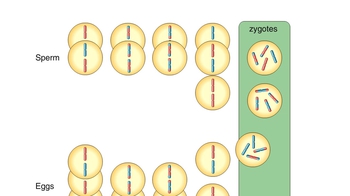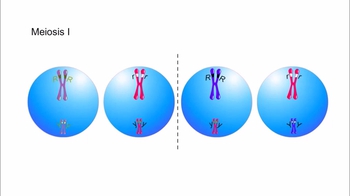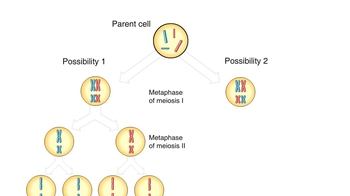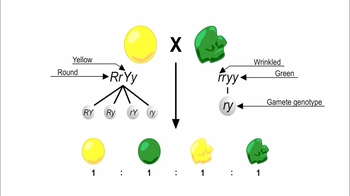Table of contents
- 1. Introduction to Biology2h 42m
- 2. Chemistry3h 40m
- 3. Water1h 26m
- 4. Biomolecules2h 23m
- 5. Cell Components2h 26m
- 6. The Membrane2h 31m
- 7. Energy and Metabolism2h 0m
- 8. Respiration2h 40m
- 9. Photosynthesis2h 49m
- 10. Cell Signaling59m
- 11. Cell Division2h 47m
- 12. Meiosis2h 0m
- 13. Mendelian Genetics4h 44m
- Introduction to Mendel's Experiments7m
- Genotype vs. Phenotype17m
- Punnett Squares13m
- Mendel's Experiments26m
- Mendel's Laws18m
- Monohybrid Crosses19m
- Test Crosses14m
- Dihybrid Crosses20m
- Punnett Square Probability26m
- Incomplete Dominance vs. Codominance20m
- Epistasis7m
- Non-Mendelian Genetics12m
- Pedigrees6m
- Autosomal Inheritance21m
- Sex-Linked Inheritance43m
- X-Inactivation9m
- 14. DNA Synthesis2h 27m
- 15. Gene Expression3h 20m
- 16. Regulation of Expression3h 31m
- Introduction to Regulation of Gene Expression13m
- Prokaryotic Gene Regulation via Operons27m
- The Lac Operon21m
- Glucose's Impact on Lac Operon25m
- The Trp Operon20m
- Review of the Lac Operon & Trp Operon11m
- Introduction to Eukaryotic Gene Regulation9m
- Eukaryotic Chromatin Modifications16m
- Eukaryotic Transcriptional Control22m
- Eukaryotic Post-Transcriptional Regulation28m
- Eukaryotic Post-Translational Regulation13m
- 17. Viruses37m
- 18. Biotechnology2h 58m
- 19. Genomics17m
- 20. Development1h 5m
- 21. Evolution3h 1m
- 22. Evolution of Populations3h 52m
- 23. Speciation1h 37m
- 24. History of Life on Earth2h 6m
- 25. Phylogeny2h 31m
- 26. Prokaryotes4h 59m
- 27. Protists1h 12m
- 28. Plants1h 22m
- 29. Fungi36m
- 30. Overview of Animals34m
- 31. Invertebrates1h 2m
- 32. Vertebrates50m
- 33. Plant Anatomy1h 3m
- 34. Vascular Plant Transport1h 2m
- 35. Soil37m
- 36. Plant Reproduction47m
- 37. Plant Sensation and Response1h 9m
- 38. Animal Form and Function1h 19m
- 39. Digestive System1h 10m
- 40. Circulatory System1h 57m
- 41. Immune System1h 12m
- 42. Osmoregulation and Excretion50m
- 43. Endocrine System1h 4m
- 44. Animal Reproduction1h 2m
- 45. Nervous System1h 55m
- 46. Sensory Systems46m
- 47. Muscle Systems23m
- 48. Ecology3h 11m
- Introduction to Ecology20m
- Biogeography14m
- Earth's Climate Patterns50m
- Introduction to Terrestrial Biomes10m
- Terrestrial Biomes: Near Equator13m
- Terrestrial Biomes: Temperate Regions10m
- Terrestrial Biomes: Northern Regions15m
- Introduction to Aquatic Biomes27m
- Freshwater Aquatic Biomes14m
- Marine Aquatic Biomes13m
- 49. Animal Behavior28m
- 50. Population Ecology3h 41m
- Introduction to Population Ecology28m
- Population Sampling Methods23m
- Life History12m
- Population Demography17m
- Factors Limiting Population Growth14m
- Introduction to Population Growth Models22m
- Linear Population Growth6m
- Exponential Population Growth29m
- Logistic Population Growth32m
- r/K Selection10m
- The Human Population22m
- 51. Community Ecology2h 46m
- Introduction to Community Ecology2m
- Introduction to Community Interactions9m
- Community Interactions: Competition (-/-)38m
- Community Interactions: Exploitation (+/-)23m
- Community Interactions: Mutualism (+/+) & Commensalism (+/0)9m
- Community Structure35m
- Community Dynamics26m
- Geographic Impact on Communities21m
- 52. Ecosystems2h 36m
- 53. Conservation Biology24m
12. Meiosis
Genetic Variation During Meiosis
Problem 22`
Textbook Question
What you think of as 'a banana' is a Cavendish, one variety of the species Musa acuminate. It is a triploid organism (3n) with three sets of chromosomes in every somatic cell. The Cavendish cannot be naturally bred; it can only be reproduced by cloning. Explain how its triploid state accounts for its inability to form normal gametes. Discuss how the lack of sexual reproduction might make the species particularly vulnerable to a new pest.
 Verified step by step guidance
Verified step by step guidance1
Understand the concept of ploidy: A triploid organism (3n) has three sets of chromosomes in each somatic cell. This is different from diploid organisms (2n), which have two sets of chromosomes, one from each parent. In sexual reproduction, gametes are formed through meiosis, which requires homologous chromosomes to pair and segregate evenly.
Explain why triploidy disrupts meiosis: During meiosis in a triploid organism, homologous chromosomes cannot pair evenly because there are three copies of each chromosome instead of two. This leads to uneven segregation of chromosomes, resulting in gametes with an abnormal number of chromosomes (aneuploidy). Such gametes are typically nonviable or result in nonfunctional offspring.
Connect this to the Cavendish banana: Since the Cavendish banana is triploid, it cannot produce viable gametes through meiosis. This is why it cannot reproduce sexually and must rely on cloning (asexual reproduction) for propagation. Cloning involves producing genetically identical offspring from a parent plant, bypassing the need for gametes.
Discuss the vulnerability due to lack of genetic diversity: Sexual reproduction introduces genetic variation through processes like crossing over and independent assortment during meiosis. This variation helps populations adapt to environmental changes, such as new pests or diseases. In contrast, cloning produces genetically identical individuals, meaning the entire population has the same genetic makeup.
Explain the risk of pest vulnerability: If a new pest or disease arises that can exploit the genetic weaknesses of the Cavendish banana, the entire population is at risk because there is no genetic diversity to provide resistance. This makes the species particularly vulnerable to extinction from such threats.
 Verified video answer for a similar problem:
Verified video answer for a similar problem:This video solution was recommended by our tutors as helpful for the problem above
Video duration:
1mPlay a video:
Was this helpful?
Key Concepts
Here are the essential concepts you must grasp in order to answer the question correctly.
Triploidy
Triploidy refers to a condition where an organism has three complete sets of chromosomes (3n) instead of the usual two (2n). In the case of the Cavendish banana, this triploid state disrupts normal meiosis, the process that produces gametes, leading to the formation of non-functional gametes. As a result, triploid organisms like the Cavendish cannot undergo sexual reproduction, which relies on the production of viable sperm and egg cells.
Clonal Reproduction
Clonal reproduction is a form of asexual reproduction where an organism produces genetically identical offspring without the need for gametes. In the case of the Cavendish banana, this means that all plants are clones of the original, leading to a lack of genetic diversity. While this allows for uniformity and consistency in desirable traits, it also means that the entire population is susceptible to the same diseases and pests, as there is little to no variation in their genetic makeup.
Recommended video:
Guided course

Fungi Reproduction - 3
Vulnerability to Pests
The lack of sexual reproduction and genetic diversity in the Cavendish banana makes it particularly vulnerable to new pests and diseases. When a new pest arrives, it can potentially affect all individuals in the population since they share the same genetic traits. This uniformity means that if a pest evolves to overcome the plant's defenses, it can devastate the entire crop, leading to significant agricultural and economic consequences.
Recommended video:
Guided course

Introduction to DNA-Based Technology

 7:08m
7:08mWatch next
Master Genetic Variation During Meiosis with a bite sized video explanation from Jason
Start learningRelated Videos
Related Practice















